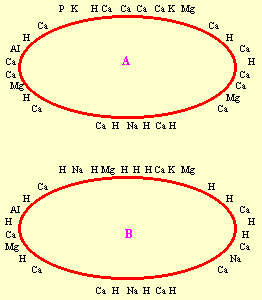 ANIONS
ANIONS
Now to the small size anions that are measured in p.p.m. They represent less than 1-4% of a soil.
Anions are negative [-] elements like phosphorous.
- Think of Anions. Think of Onions.
- Remember that onions make you cry &
It always makes you cry to sign your phosphate bill!
Other anions include for example:
| Sulphur |
[S-] |
Molybdenum |
[Mo-] |
Carbon |
[C=] |
| Boron |
[B-] |
Chlorine |
[Cl-] |
|
|
All the elements are detailed in a further publication named [SPAN]
SOIL PLANT & ANIMAL NUTRITION.
WHERE DOES NITROGEN FIT IN?
- Nitrogen can be taken up in different forms:
- N can come to the plant in a - or + form.
- NH4+ or N02- or NO3-.
WHAT ABOUT WATER?
Water can be taken up in different forms as well:
H+ or 0H-
YOUR SOILS IN MINIATURE
So the cations [~95%] and the anions [~5%] are jointly held and add to the nature of the
individual soil particles.
Your soil is made up of billions of individual soil particles.
The amount of positive or negative charge on each particle affects the way that it reacts.
For example a soil high in Magnesium when wet is very sticky, but in summer it cracks open.
- Generally Magnesium pulls soil particles together
- Calcium helps to keep soil particles apart
Therefore in theory [and in practice] you need a higher percentage of Magnesium in a light sandy soil
to bind and glue the soil. A heavy clay soil needs a higher percentage of Calcium to open the soil up
and to let it breathe.
Each soil particle has a number of sites or car parks in it. Please note that the following diagram
is an illustration only. (Think of the car-park as having a - negative charge, with the cars having a +
positive charge being attracted to it.). Remember: This is a graphical representation only!
Which soil is the good soil and which is the poorer one and why?
Would you choose A or B.

[A clue count up the number of each element, note the ratios. Are there any elements missing?]
The information contained in this publication has been formulated in good faith, the contents do
not take into account all the factors which need to be considered before putting that information
into practice. Accordingly, no person should rely on anything contained herein as a substitute for
specific professional advice.
S.O.S. Rev 9.2 All rights reserved.
Contact: www.healthyag.com © Gwyn Jones 2001
Back to Soils Menu
PAGE
1 - 2 -
3 - 4
|

![]() Home
Home![]()
![]() History
History![]()
![]() Catalogue
Catalogue![]()
![]() Courses
Courses![]()
![]() Top Ten
Top Ten![]()
![]() Links
Links![]()
![]() Site Map
Site Map![]()
![]() Contact
Contact


